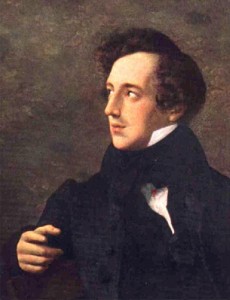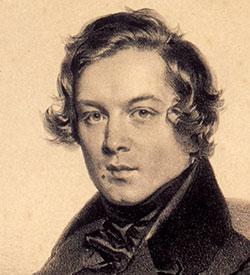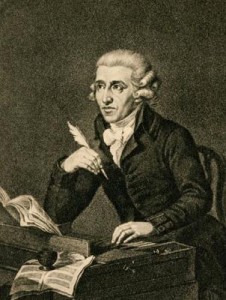(First time using “Explore the score?” Just click on the hyperlinks within the text to hear the musical excerpts.)
“Here is something truly symphonic, a gesture worthy to introduce a great work…”
Hans Gál, Schumann Orchestral Music
“I sketched it at a time when I was ailing, and I may well state that it was, as it were, the power of resistance of spirit that has influenced my work, and by which I have tried to prevail against my physical condition”
Robert Schumann
It was in August of 1844 that Robert Schumann (1810-1856) first began to feel the symptoms of a terrible illness, one with a complex list of symptoms: “dizziness, weakness and pain in the limbs, rheumatism, disturbance of vision, insomnia, and hearing problems”.[1] Of these, Schumann’s hearing problems were the most worrying. He found that listening to music caused him acute physical pain: “I really have not been able to listen to music for quite some time, it cuts into my nerves as with knives.” Although Schumann suffered from anxiety and melancholy during his illness, he sensed that his symptoms were physical in origin, and modern research has now confirmed that his condition during those months was very likely brought on by the syphilitic infection that would eventually kill him.
By the beginning of 1845, Schumann’s health gradually began to improve, and he embarked on an intense study of counterpoint, immersing himself in the music of J.S. Bach. At the end of February , he returned to composition, completing a remarkable series of neo-Baroque works, mostly fugues or fugal studies. Emboldened by this project, he took up his Phantasie for Piano and Orchestra, written for Clara in 1841, revising and expanding it into the Piano Concerto, op. 54 we know today. Although Schumann would continue to note a variety of physical complaints throughout 1845, the completion of the Piano Concerto marked his return to full strength as a composer.
Order the complete recording here:
Moreover, the many hours Schumann had spent in silence working on contrapuntal studies had forever changed his working methods. “I have written the majority, almost all, even the smallest of my pieces while inspired, many of them at unbelievable speed;” he wrote. “For example my first symphony in B-flat in four days, a song cycle of twenty pieces likewise… Only from 1845 on, when I began to invent and work out everything in my head, did a completely different way of composing start to develop.” As a young composer, Schumann had been completely dependent on his gifts as an improviser at the piano, but from 1845 on, he no longer kept a piano in his studio. The Symphony in C Major was the first major piece undertaken in this new way of working. It was actually Schumann’s fourth work in the genre, preceded by the “Spring,” the first version of the D minor Symphony, later to become his Fourth, and his “Sinfonietta,” (the Overture, Scherzo and Finale.) He set to work in earnest on the piece after hearing a performance of Schubert’s “Great” C major Symphony on the 9th of December, 1845, completing it in 1846. Mendelssohn conducted the premiere on the 5th of November, 1846 in the Leipzig Gewandhaus.

Felix Mendelssohn, Schumann’s closest musical collaborator and conductor of the premiere of the 2nd Symphony
Three threads in Schumann’s life and work came together in this piece- his sense of struggle and resistance forged in the dark days of late 1844, the immersion in Bach and the ensuing “new way” of working. There was also a profound sense of gratitude to Clara for her support in difficult times. The symphony is full of ciphers, codes, quotations and references to other music. The master of cipher and quotation is, of course, JS Bach, and, as it turns out, Schumann’s second 2 is one of the most Bach-ian symphonies ever written.
Bach is invoked in the very first bars of the symphony, as Schumann opens the piece with an Introduction (Sostenuto assai) that is, in essence, a chorale prelude; one of the most Bachian of forms. Above an endlessly self-reinventing and re-developing melody in the strings, we hear a simple and declamatory theme. Just as Bach would usually use a Lutheran chorale not of his own creation in his chorale preludes, Schumann’s chorale theme is also a quotation of the opening of Haydn’s last symphony, no 104. Could Schumann be claiming a link with the father of the symphony?
One work that we know Schumann spent a lot of time studying during his convalescence was Bach’s Musical Offering. The following Allegro ma non troppo is a study in perpetual motion, most of it generated from a simple four note ostinato theme which is treated with something like the same obsessiveness with which Beethoven developed the “Fate” motive in the first movement of his Fifth Symphony. It is in this Allegro that we sense the “power of resistance of spirit” which Schumann said the Symphony embodied. This is music that, while certainly obsessive in its use of repetition, is in a constant state of metamorphosis, with intervals and harmonies constantly shifting, much like the string-theme in the introduction. As it happens, this ostinato rhythm is taken from the first bar of the Trio Sonata (Largo) of The Musical Offering; a piece that we’ll hear more of later in the symphony.
The following Scherzo (Allegro vicace) is a tour de force for orchestra and composer. The fiendishly difficult first-violin part is a rite of passage for every aspiring violinist, an excerpt that is heard in almost every orchestral audition. It is a brilliant, inventive movement with two very different trios; one spry and witty, and the other soulful and rarified. The second trio begins with a beautifully crafted four-part chorale, the theme of which is then made the subject of a brief contrapuntal episode. Throughout this Trio, the spirit of Bach is felt in every bar, especially once we realize that the second part of the theme is a quotation of the musical B-A-C-H motive (Bb-A-C-B natural). All the more remarkable is that we can see that the B-A-C-H theme is almost identical to the main theme of the first movement, especially when it is transposed up a fourth later in the trio (Eb, D, F, E natural here, E, D, F, D in the first movement – surely no accident, given Schumann’s love of developing new themes by changing one note at a time). The movement reaches its joyous culmination in a return of the Haydn fanfare.
The third movement (Adagio espressivo) begins with what sounds like the most heart-wrenching and Schumann-esque of melodies. But Schumann had borrowed it from Bach. Where the Allegro ma non troppo was based largely on the rhythm of the Trio Sonata of the Musical Offering, this violin melody is an almost note-for-note quotation of the pitches from same source. Stylistically, Schumann sets the Bach theme as a Romantic song-without-words; very much Bach in the style of Schumann. In the dark heart of the movement, however, lies a bleak fugal episode; Schumann in the style of Bach. Many hear this movement as a depiction of the despair and isolation Schumann felt during his illness – cut off from music, activity and friends. In its pathos, expressivity and long-breathed lines, it is the quintessential Romantic slow movement, but throughout the movement the independence of voices and the echoes of the Baroque master recall the influence of Bach.
The Finale (Allegro molto vivace) was the movement in which Schumann said that for the first time since his illness started he “began to feel like myself again.” After the introversion and fragility of the slow movement, it is hard to imagine a stronger contrast. The Finale explodes into life, with a fortissimo scale for all the strings, followed by a bracing and very fast march with a striking resemblance to “Es lebe Sarastro, Sarastro soll leben” (“Long live Sarastro, Sarastro shall live!”) from The Magic Flute; a celebration of life that very much sets the mood of the movement. The rhythm of this march-theme (a long note followed by a dotted rhythm) appears so frequently in his music that some commentators call it the “Schumann rhythm.” In fact, even the quotation from Haydn that begins the symphony is a version of the Schumann rhythm. Now, coming after the darkness and despair of the Adagio, this rhythm creates a powerful sense of self-assertion, as if the composer is announcing- “Es lebe Schumann, Schumann soll leben!”
This Finale, one of Schumann’s most formally original and successful movements, unfolds in three large sections. The first is dominated by the opening scale and the “Es lebe” theme, with the springing, explosive impetus of the Schumann rhythm to the fore. The second episode is largely stormy, in which the Bach theme of the Adagio returns, as despairing as ever, but now also full of anger and agitation. The music eventually collapses back into the darkness of C minor, the key of the slow movement.
What follows is one of the most tender and miraculous moments in any symphony. After the shortest of silences, the oboe introduces a new theme, breathtaking in its tenderness and simplicity. So begins a song of thanks to Clara, a gesture Schumann will soon make explicit. Gradually, more voices join this new song and the musical temperature rises. When the strings bring back the rising scale that opened the movement, one gets a sense the music is on the edge of returning to the extrovert triumphalism of the opening, which had burst forth with such confidence, only to collapse into crisis. So it is – this music seems determined to spin out of control, building to a frenzied climax and a fortissimo fermata on the dominant chord.
After another short but pregnant silence, the mood of tenderness returns. Schumann has re-arranged a note here and an interval there in the oboe theme, as only he could (much as he had in introducing the B-A-C-H-motive in the 2nd movement). The result is a quotation of the final song of Beethoven’s An die ferne Geliebte (To the Immortal Beloved), where Beethoven sets the words “Take them then, these songs.” And what songs he offers. Theme by theme, Schumann works his way back through the symphony- first reworking Bach’s Musical Offering motive, then gradually returning to the ideas of earlier movements, particularly the themes of the symphony’s opening. Along the way we find reference to one more song – by Schumann himself – Widmung (Dedication), presented to Clara on their wedding day.
It was indeed an act of dedication and a song of thanksgiving and love for Clara. Beethoven’s great hymn of thanksgiving was the Heiliger Dankesang from the op. 132 quartet, a reverent and deeply personal statement of thanks to God, but Schumann sings of his gratitude for human love, and when Haydn’s fanfare returns at last, we know it is a call to celebration.



Hi Kenneth
Just saw an exciting performance of this work on the Berlin Philharmonic’s Digital concert hall with Simon Rattle (Jan 2011).
I play in a community orchestra in Adelaide, South Australia and it’s always the Rhenish.
Shame that this work isn’t as well known as the first and third symphonies.
@Michael Lofting
I’ve seen the Rattle- what a band! I agree the 2nd should be heard more often, but it is the toughest of the Schumann’s, especially for the violins (the Scherzo is a real virtuoso piece).
Thanks for the comment
Ken
Hi Ken,
Schumann’s second symphony has always been one of my favorites ever since I heard it for first time many years ago. Thanks for this input; it made the performance I just attended even more enjoyable.
It seems the symphony is performed more frequently these days. This concert season, there were four (!) performances here in the immediate region, if my count is correct. That’s two more than Schumann’s ever popular third symphony. In previous seasons, there have been only few occasional performances of Schumann 2 if any at all.
Hopefully, this count indicates a trend, and Schumann’s second won’t remain „one of the greatest unloved symphonies“. After all, the symphony is an obvious and effective alternative to some pieces performed all too frequently.
This is a great writing on the symphony! I thoroughly enjoyed reading this! Thank you :)
Thank you for the analysis!
I find in the fourth movement a quite clear citation of “Esurientes implevit bones, et divites dimisit inanes” from Bach’s Magnificat.